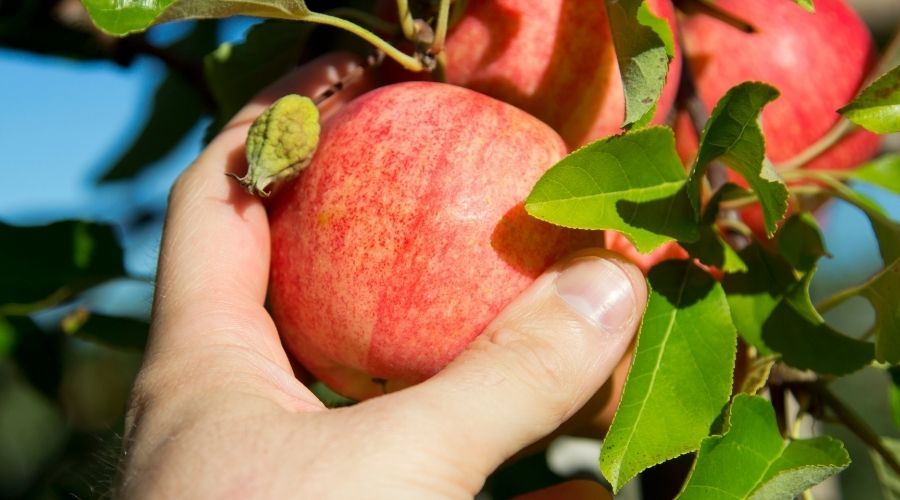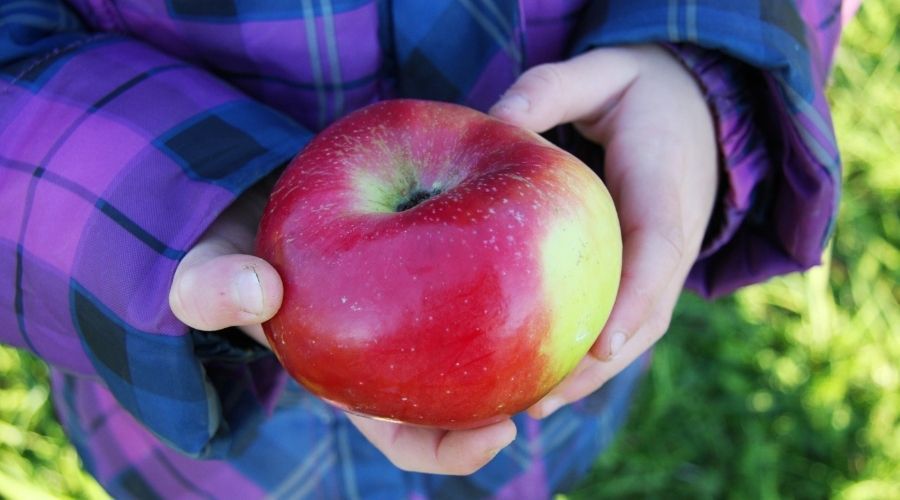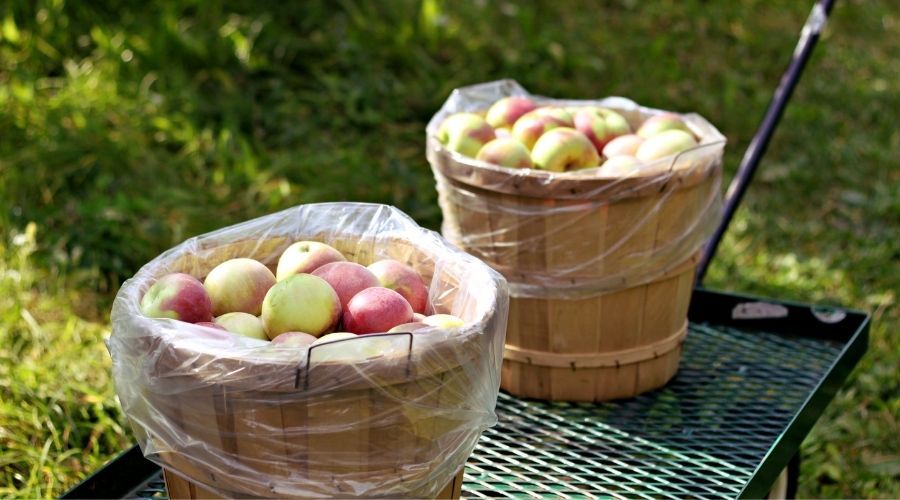Apples are a highly popular fruit for several reasons. With so many different varieties available and the ability to store some for months after harvest, there are apples available year-round for your snacking and baking needs. They’re also highly versatile, adding flavor to pies, pastries, sauces and salads. But when is the best time to pick apples?
Below, we’re going to share our best tips for harvesting and storing apples, including how to identify ripe apples, the best way to harvest apples and important considerations when storing your apples for the winter months.
When Are Apples in Season?
The ‘season’ for apples will range depending on the variety of apples that you’re growing. In fact, there are 2,500 different varieties of apples grown in the United States, each slightly different from the next. For some varieties, harvest season could last several months with up to three or four harvests for each tree. Other varieties have a very short harvest period, requiring you to pick and store all the apples at once.
When discussing apple season, most gardeners are referring to the span from late July to early November. However, there are a few varieties that don’t fall into this timeline. For example, depending on your location, the Lodi apple may be ready for harvest as early as June some years.
When Are Apples Ripe and Ready to Pick?
Different apples will ripen at different points in the harvest season. Additionally, a single tree can have apples ripen at different times, providing for multiple harvests. This means that it’s important to learn how to recognize when an apple has ripened and when it needs more time.
There is no one way to know that your apples will be ripe that can apply to all varieties of apples available. However, there are some tips that can help to give you a general idea of what to watch for. With experience, you will learn which of these indicators will work with your specific variety.
Color
The most common indicator that is discussed is color. An apple starts off green and, depending on the variety, will slowly transition into the final desired color, including red, yellow or other shades of green. This is hard to determine with green apples like the Granny Smith, due to the lack of color change. Also, there are some varieties of apple, like the Red Delicious, that will change color long before they’re ripe enough for harvest.
Another way of using color to help you decide is by looking at the ‘ground color’, or the color directly around the stem of the apple. In some apples, such as the McIntosh, this color will change from a bright green to a yellow as the apple matures.
Seed Color
The skin of the apple isn’t the only part that changes color in most varieties, as the apple matures. If you slice an apple in half, you can check the color of the seeds to better understand what stage of maturity it’s at. The seeds of most apple varieties will darken and turn brown as they mature. However, there are some apples that have naturally light-colored seeds. Additionally, some apples have seeds that will turn brown before they’re mature.
Firmness
As an apple matures, the flesh of the fruit will become softer. Therefore, monitoring the firmness of the apples can help you to identify the stage that your apples are currently at. To check, hold the apple in your palm and apply pressure lightly with your thumb. Immature apples are incredibly hard, while overripe apples are soft to the touch. Ideally, you want to harvest when the flesh of the apple is still firm, but not overly hard. There is no exact science to this approach, which means that it can only be learned from experience.
Taste
If you’re unsure of the firmness, you can harvest a single apple for a taste test. Immature apples have a very starchy taste. As they mature, this starch is slowly converted to sugars, making the apple sweater to the taste. This process also helps to strengthen the flavor of the apple. An apple that is overripe has completely converted the starch to sugars. This is one of the easiest methods for those who are newer to growing and harvesting apples.
Fruit Drop
The easiest way to tell if your apples are reaching maturity, or not is to simply watch for the fruit to start dropping from the tree naturally. As the fruit matures, it’ll become easier for the apple to separate from the tree. When you’ve seen a few healthy, mature apples (not rotten or diseased), that is a sign that the apples on the tree are nearly mature and ready to drop as well.
How to Harvest and Store Apples?
Harvesting Apples
Apple picking is an activity that can be enjoyed by the entire family, whether you’re harvesting apples at home or visiting a local orchard. To find the apples that are ready to be harvested, you want to look for smooth skin with no bruises or nicks. The further away from the trunk that an apple is, the faster it’ll ripen. So, start with the apples that are further out on the branches.
To pick the apple from the tree, hold it in the palm of your hand. The pressure from your fingers can damage the apple before it’s even harvested. Lift the apple upwards slightly and give it a slight twist. This will separate the stem from the branch, keeping the stem on the apple, which helps it to stay fresh longer. Avoid pulling at the apple, as this will leave the stem behind. Carefully place your apple into your bag or basket to prevent bruising.
You also want to avoid shaking the branches, or climbing the apple tree. Doing so will cause apples to fall to the ground, which can damage them. Additionally, you may damage the tree, which can prevent it from producing apples again the following year.
Proper Apple Storage
Whether or not your apples will be able to be stored will depend on the season that they ripen. Apples that are harvested during the early season are best when eaten fresh, as they don’t hold up well in storage. Midseason apples are a little more suited for storage, and can be kept for a few weeks in the proper conditions. However, the best apples for storing are late season. These apples can be stored for up to five months, if everything is done properly.
If you’re looking for apple varieties that are known to store better, consider the thicker-skinned and tart varieties, such as Fuji, Granny Smith, McIntosh, Northern Spy and Rome.
Before storing your apples, you need to check them over for any bruises, blemishes, or signs of rot. Once an apple has started to turn, it can’t be prevented. Only those apples that are in the best of condition should be kept for an extended period, the rest should be eaten in the days following harvest.
When Storing apples, they should be kept in a cool, dark, and well-ventilated space, such as a shed, garage or basement. Wrap each apple individually with kraft paper, newspaper, or tissue paper to keep them separate, as they give off ethylene gas, which speeds up the ripening/decaying process in nearby fruit. After they’re wrapped, spread them out on a tray, allowing for air to flow freely.
Make sure to check your apples regularly, as they will continue to ripen, while in storage. If you notice that an apple is getting soft, it needs to be eaten before it goes bad. Remove any that are getting ripe, or spoiling to avoid ruining the rest of your batch. This is a great way to save money by enjoying apples for months after the harvest season has ended.
Are You Ready to Grow and Harvest Apples?
With a little care and consideration, a single apple tree could provide you with delicious fruit for years to come. You can maximize your harvest by carefully removing apples from the tree, taking note of any dead branches or causes of concern, and pruning your apple tree each year. Not only will pruning your tree help to maintain the health of the tree, but it’ll also work towards increasing the harvest and even improving the quality of the apples themselves.
We hope that the above information will not only help you with the process of harvesting your apples, but also to select the best variety of apples for your needs. Let us know in the comments section below, which of these advice you believe is most useful.



